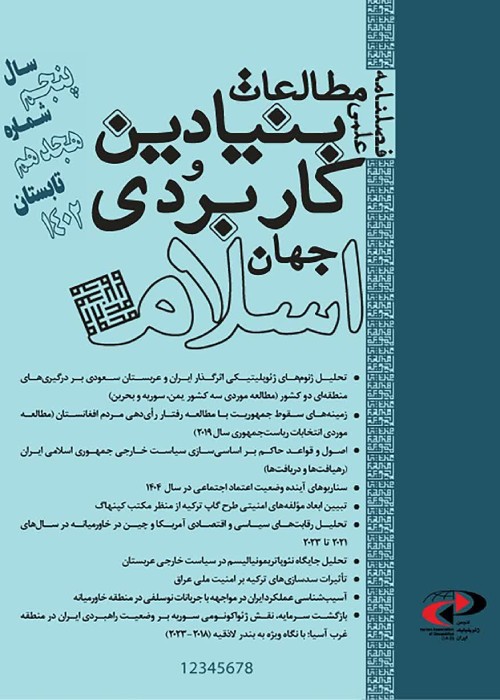Consequences of completing the Arab Mediterranean corridor and the challenges facing the Islamic Republic of Iran
Author(s):
Article Type:
Research/Original Article (دارای رتبه معتبر)
Abstract:
The present age can be considered the age of corridors in the world. The present century is called the century of corridors because of the importance of the movement of goods and the means of communication that can overshadow the geoeconomics of different regions. For this reason, in geo-economics, the routes that can form the land and sea communication route between countries, regions, and even continents are of great importance. The Middle East region has always been considered an important region in this regard; because for a long time, the world has been the communication route from east to west and vice versa. The vastness and geopolitical position of the Middle East has always led to the passage of various important trade routes through this region. This feature can be seen in the periods of formation of ancient civilizations and the efforts of various civilizations in this region to dominate important highways. Among the most important roads that passed through this region, we can mention the Silk Road, which is as old as the life of the civilizations in this region. For this reason, the importance of this region can’t be considered solely dependent on the provision of world hydrocarbon resources by countries in the region; rather, the role of this region and its gateways in the transit routes of the world can be an important element in the importance of this region in the eyes of other world powers. In recent years, the transit importance of the Middle East region has increased due to changes in the political, security, and economic structure of the world and regional order. Especially since the world economic structure has undergone serious changes with the significant and growing growth of India and China as two Asian powers. India, along with China, is considered one of the most important economic powers in the world.The Arab-Mediterranean Corridor is one of the most important projects between the crossings through the Persian Gulf region and the member states of the Gulf Cooperation Council. The corridor starts at the port of Mumbai in India and crosses the Oman Sea via some parts of the Saudi Arabian Peninsula to the port of Haifa in the eastern Mediterranean, ending at Europe by sea. To this end, India, to be able to supply its various goods to different parts of the world, has directly designed and implemented transit projects around it. In particular, in the meantime, India has been economically engaged with a rival such as China and has drawn strategic and diverse polls so that its economic interests do not interfere with a great power like China. One of these important steps in the strategic documents of the Government of India is the passage called the Arab-Mediterranean Corridor with the Indo-European Corridor. The initial route starts from the west coast of India and originates from the port of Bombay and reaches the ports of the United Arab Emirates by sea, where it connects by land to Saudi Arabia and finally by rail from Saudi Arabia to Jordan and the regime. It connects to Zion and ends at the port of Haifa on the east coast of the Mediterranean. It is noteworthy that this route eventually reaches Greece and Rupa by sea. In the meantime, this trade route can be the most important and economical route from India to other parts of the world. from this route, India will be directly connected to Europe and its market.It seems that the completion of this roadmap, which requires the provision of political, security, and economic grounds among the countries involved, could have consequences, and these consequences could overshadow the interests of the Islamic Republic of Iran in the region. To this end, the authors of the present study sought to answer the question of how the consequences of the Arab-Mediterranean Corridor project will affect the security and economic interests of the Islamic Republic of Iran in the region. Using the descriptive-explanatory method, the authors have reached the hypothesis that "the consequences of completing the Arab-Mediterranean project can be summarized in the geopolitical change of the region, strengthening the formation of an economic-political crescent by the Hebrew-Arab axis and strengthening relations between countries along this corridor. As a result, the completion of the Arab-Mediterranean corridor will change the geopolitics of the region and reduce the strategic importance of Iran's southern borders to the Strait of Hormuz, and these issues will create economic and security threats to the Islamic Republic of Iran in the region."
Keywords:
Language:
Persian
Published:
Journal of Fundamental and Applied Studies of the Islamic World, Volume:4 Issue: 11, 2022
Pages:
64 to 92
magiran.com/p2453139
دانلود و مطالعه متن این مقاله با یکی از روشهای زیر امکان پذیر است:
اشتراک شخصی
با عضویت و پرداخت آنلاین حق اشتراک یکساله به مبلغ 1,390,000ريال میتوانید 70 عنوان مطلب دانلود کنید!
اشتراک سازمانی
به کتابخانه دانشگاه یا محل کار خود پیشنهاد کنید تا اشتراک سازمانی این پایگاه را برای دسترسی نامحدود همه کاربران به متن مطالب تهیه نمایند!
توجه!
- حق عضویت دریافتی صرف حمایت از نشریات عضو و نگهداری، تکمیل و توسعه مگیران میشود.
- پرداخت حق اشتراک و دانلود مقالات اجازه بازنشر آن در سایر رسانههای چاپی و دیجیتال را به کاربر نمیدهد.
In order to view content subscription is required
Personal subscription
Subscribe magiran.com for 70 € euros via PayPal and download 70 articles during a year.
Organization subscription
Please contact us to subscribe your university or library for unlimited access!


